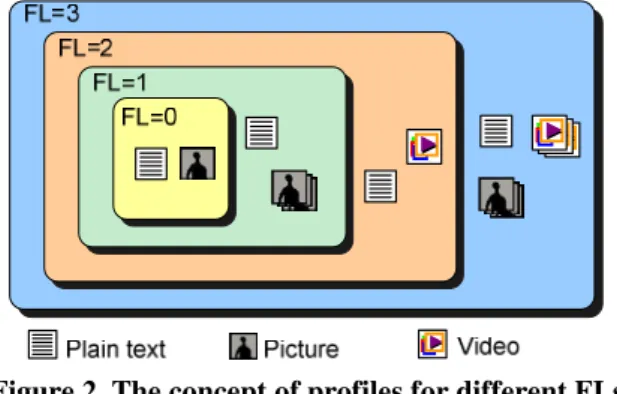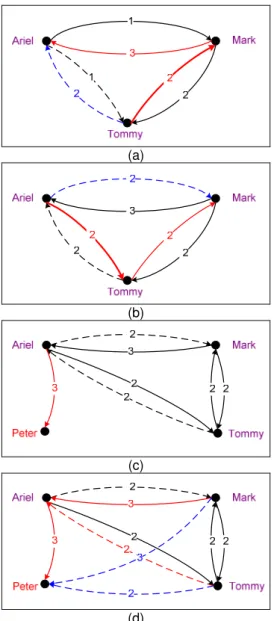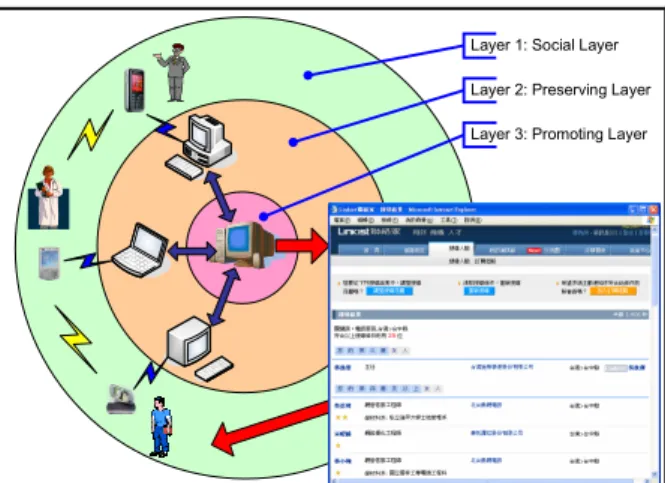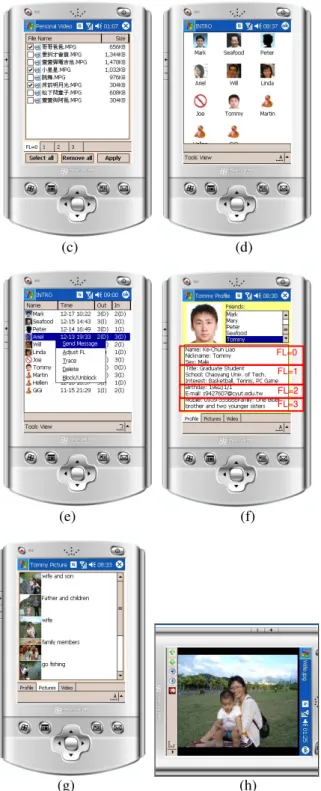INTRO: the Design of a Social-Mobile Framework for Enhancing the
Social Interactions
Hsien-Chou Liao and Ke-Chun Liao
Department of Computer Science and Information Engineering
Chaoyang University of Technology
E-mail: hcliao@cyut.edu.tw
Abstract
The capabilities and wireless communications of mobile devices are getting more and more powerful. Except the professionals, the mobile devices are popular used by the non-professionals. How to enhance the social interactions via the mobile devices becomes an important issue in recent years. In a social activity, a people’s profile must be presented repeatedly when he is introduced to another people. It is unnecessary and troublesome. A social-mobile framework, call INTRO, is proposed in this paper. It is a three-layer framework that consists of social, preserving, and promoting layers. Thus, mobile devices enhance the social interaction by distributing the social profiles automatically in the social layer. The distribution is based on a dedicated graph, called familiar graph (FG). The received profiles can be stored into the desktop PC in the preserving layer. In advance, the connections between people can update to web sites for promoting the social interactions. A prototype of INTRO in the social layer is implemented to demonstrate its feasibility.
Keywords: social-mobile application, mobile computing, familiar graph.
1.
Introduction
Recently, the wireless communication causes mobile applications are getting popular. The computing power evolution of mobile devices also extends the application domains of mobile applications. Mobile devices become an important instrument for delivering information technology into people daily life. They also change the way people interact with people or the physical world, e.g., SMS (short message service). One of the important activities is the social activity. Many researches focus on how to enhance the social interactions via the mobile devices. For example, N. Eagle et al proposed social-mobile software for smart phone, called social serendipity [1]. It is a mobile-phone-based system using bluetooth communication for face-to-face interactions between nearby users. Its purpose is mainly to facilitate interactions between physically proximate people through a centralized server. R.
Beale proposed a set of social applications on the smart phone [2]. For examples, the localized dating, file sharing, community building, mobile blogging, etc. It demonstrates the ability of smart phone on supporting the social interactions and makes pervasive computing a reality.
In this paper, we focus on how to enhance the interactions in a social activity. If a person knows nobody in a social activity, he has to explore the connections by himself. Oppositely, if the person has several friends in the activity, he can explore the connections faster via his friends. When the person is presented to a friend’s friend, they may interchange the name cards. However, the information on the name card is too simple. The detail profiles must be presented to each other repeatedly. It is inefficient and inconvenient way for social interactions. Besides, the profiles kept in the human memory may be lost after a period of time. When a person blunders an unfamiliar friend someday, he has to remind personal profiles again.
In order to overcome the above problem, a three-layer framework, called INTRO, is designed to cover the interactions in the social activity to the social web sites. The three layers are social, preserving, and promoting layers. In the social layer, the connections among people forms a graph, called familiar graph (FG). A link inference mechanism is defined to extend and maintain the consistency of the connections. The mobile device can help to interchange social profiles automatically based on the FG. People can know the profiles as soon as possible once they join a social activity. In advance, the storage constraint causes it is difficult to store all the received profiles in the mobile devices. And, the display constraint also causes that it is inconvenient to view profiles on the mobile devices. The preserving layer is thus designed for the preservation of received social profiles. Mobile devices can synchronize the received profiles with desktop PCs or notebooks. It is easier to view or comment profiles on a desktop PC or Notebook. Moreover, the preserved social connections can synchronize with the social web site. The social interactions can be promoted in such a way. The third layer is called promoting layer. A prototype of the social layer is also implemented to demonstrate INTRO’s feasibility.
Section 2 reviews related works. Section 3 presents the approach based on the familiar graph and three-layer framework of INTRO. Section 4 presents the prototype of INTRO. Section 5 gives the conclusion and future works of our research.
2.
Related Works
Recently, some researches focus on the enhancement of social interactions via the mobile devices. For example, N. Eagle and A. Pentland developed architecture to detect an individual to other people nearby [1]. An application of the architecture, called Serendipity, combines an online introduction system to facilitate interactions between physically proximate people through a centralized server. Serendipity consists of three parts: BlueAware (BlueDar) and Serendipity Server. BlueAware can be executed in the background on many Bluetooth phones. BlueAware scans the unique Bluetooth identifier (BTID) number of mobile phones. It then records and timestamps the BTIDs encounters. BlueDar is a variation of BlueAware. It can be deployed in public areas. BlueDar transmits detected BTIDs to the Serendipity server via wireless network. The serendipity server can match the mobile profiles according to the thresholds set from their phone, and thus increase the interactions among physically proximate people.
R. Beale designs seven systems to demonstrate the ability of smart phones on supporting a wide range of social interactions [2]. Systems include Bluedating, BT Communities, BT Share, SmartBlog, etc. Bluedating application is a localized dating service. It allows users to enter their interests and desires. The application continually searches for other profiles over Bluetooth. If discovered profile and desired profile is match, the application informs both users by vibrating. BT Communities provides a software framework that can run and manage Bluetooth services. Many applications can be built based on the BT Communities, such as joke-sharing, or char facility. BT Share is a peer-to-peer file-sharing system. Files can be identified as being public and open for sharing. The sharing files may encourage the fact-to-fact social interaction.
J. Kjeldskov and J. Paay designed a context-aware mobile information system, called Just-for-Us, facilitating sociality in public places. Its design is mainly based on four ideas. Firstly, Just-for-Us makes the invisible visible by augmenting the user’s physical surroundings. A “home screen’ is pushed to the device displaying information corresponding to the district where the user is located. The home screen consists of the district’s name and textual descriptions, an annotated panoramic view, and activity meter. Secondly, Just-for-Us supports Ad-Hoc communication about places, activities, and time. It notifies users when their friends are nearby and displays on the mobile devices automatically.
The nearby stores, such as restaurants, coffee shops, etc., are also displayed on the screen for arranging the meeting places. Thirdly, Just-for-Us supports indexing recommendations of activities, such as coffee, food, or cultural events. It presents a list of recommendations sorted on the basis of user’s history. Lastly, Just-for-Us represents activities within proximity and indexing to familiar places. People often use this information as important cues for where to go and what to do themselves. The prototype of Just-for-Us exemplified how its information and functionality can be tailored to the user’s physical and social setting.
According to the above results, mobile devices can be an important instrument for enhancing the social interactions. INTRO is mainly designed to support the interactions from the physical social activities to the virtual web sites.
3.
Approach
3.1 Familiar graph
The relationships between people can be modeled as a graph. A node represents a people and a link represents the familiarity. Two people may have different familiar level (FL) to each other. For example, ‘Mark’ may feel he is closely familiar with ‘Ariel’, but ‘Arial’ may feel she is not so familiar with ‘Mark’. The links should be directed and weighted to represent the different FL of two people to each other. Besides, the link of two people may be direct or indirect. An indirect link means the relationship of two people is established via another people.
According to the above description, a familiar graph (FG) is defined. FG is a weighted directed graph. There are two types of links: direct or indirect, which are represented as solid or dashed line, respectively. The label of the link represents the FL. There are four FLs from zero to three in current design. FL equals to zero and three means unfamiliar and closely familiar, respectively. An example of FG is show in Figure 1. In Figure 1 (a), there are three people in the figure. The label of the link from ‘Mark’ to ‘Ariel’ is three means that ‘Mark’ feels that he is closely familiar with ‘Ariel’. However, the label of the reversed link is one means that ‘Ariel’ feels she is not so familiar with ‘Mark’. There is an indirect link from ‘Ariel’ to ‘Tommy’. It is derived from the path (‘Ariel’, ‘Mark’, ‘Tommy’). Its label is assigned as the minimal FL in the path. The complete rules of link inference are presented in the later section. The default label of the link between any two nodes is zero. When the quantity of nodes is large, the FG will look complicated. Therefore, the link with label zero is ignored in the rest figures of this paper as shown in Figure 1 (b).
(a)
(b)
Figure 1. Familiar graph examples (a) a complete example (b) a simplified example by ignoring the
links with the label zero
A people can setup the social profile for different FLs. The profile may include text, picture, video, etc., and it is getting details as the increasing of FLs. The transmission of social profile is determined by the FL of the link. Assume the label of a link from a node P1 to P2 is n, all the P1‘s profile while the FL is smaller or equals to n is combined and transmitted to P2. The above concept is shown in Figure 2. A plain text example of the social profile for ‘Tommy’ with different FLs is also listed in Table 1.
Figure 2. The concept of profiles for different FLs Table 1. An example of social profile for different
FLs
FL Social Profile
0
Name: Ke-Chun Liao Nickname: Tommy Sex: Male
1
Title: Graduate Student School: Chaoyang Univ. of Tech. Interest: Basketball, Tennis, PC Game 2 Birthday: 1982/1/1
E-mail: s9427607@cyut.edu.tw
3
Mobile: 0939-555666
Family: One elder brother and two younger sisters Home Addr.: No. 81, Lane 130, Sec. 2, Xinping Rd., Taiping City, Taichung County 411, Taiwan
(R.O.C.)
According to the above definition of FG, two issues are considered as well.
(a) The indirect link inference and FL determination
People are represented as nodes in FG. There are two types of links: direct and indirect. The direct link is established by peoples. People can also determine the FLs of out-direct-links. That is, people can actively control the details of profiles for each friend individually. Oppositely, the indirect links are established by the link inference mechanism. The algorithm for the indirect link inference and FL determination is listed in Figure 3. Assume there is more than one path between two nodes, the minimal FL of a path is found to ensure that only the profiles under the minimal FL can be transmitted via this path. Then, the maximal value of these minimal FLs is found to allow the profiles can be transmitted via the path with this value. Two directions between two nodes are checked and the indirect links with the maximal value are established.
Algorithm Infer_Indirect_Link (FG)
Input: FG (a familiar graph) Output: FG’ (a modified FG)
begin
for every pair of nodes (n1, n2) in FG
explore all the paths from n1 to n2, i.e., (n1,…, n2) find the minimal FL (Min_FLi) for every paths
find the maximal FL (FLmax) among Min_FLi
if FLmax > FL of the current direct link from n1 to n2
set the link type from n1 to n2 as ‘indirect’
set FL of the indirect link from n1 to n2 as FLmax
end if
explore all the paths from n2 to n1, i.e., (n2,…, n1) find the minimal FL (Min_FLi) for every paths
find the maximal FL (FLmax) among Min_FLi
if FLmax > FL of the current direct link from n2 to n1
set the link type from n2 to n1 as ‘indirect’
set FL of the indirect link from n2 to n1 as FLmax
end if next end
Figure 3. The algorithm of indirect link inference and FL determination
The inference process is activated when the FL of a link is adjusted by people or new people are added into the FG. An example is shown in Figure 4. The initial FG is shown in Figure 2 (b). After the conversation of ‘Tommy’ and ‘Mark’, ‘Tommy’ adjusts the FL of ‘Mark’ from zero to two as the bold red line Figure 4 (a). It causes the FL of the link from ‘Tommy’ to ‘Ariel’ is also adjusted from zero to two after the inference process. Similarly, when ‘Ariel’ adjusts the FL of the link to ‘Mark’ from one to two, the link type is also changed from indirect to direct. It also causes the FL of the link from ‘Ariel’ to ‘Mark’ is adjusted from one to two. The line type is also
changed from direct to indirect as show in Figure 4 (b). Then, ‘Peter’ joins the social activity. He is a friend of ‘Ariel’ and she is closely familiar with ‘Peter’ as shown in Figure 4 (c). It causes that two indirect links from ‘Mark’ and ‘Tommy’ to ‘Peter’ can be established after the inference process as show in Figure 4 (d). ‘Peter’ can know the profiles of ‘Mark’ and ‘Tommy’ as soon as possible.
(a)
(b)
(c)
(d)
Figure 4. An illustration of link inference (b) FL conflict resolution
In a social activity, the FLs of a FG can keep consistent by using the inference mechanism. Every mobile device contains a partial copy of the FG. People may adjust the FLs after the social activity. Once people meet at a different social activity someday, the FLs of the same link may be different (conflict). Thus, a FL conflict resolution mechanism must be defined to overcome the condition. An example of the FL conflict is shown in Figure 5.
(a)
(b)
Figure 5. An example of FL conflict (a) original FG (b) conflict occur
The original consistent FG is shown in Figure 5 (a). Every people store a copy of the FG and the copy can be represented as a table. The columns ‘In’ and ‘Out’ represents the in-link and out-link with the FL and link type. The symbols ‘D’ and ‘I’ of the link represent the link is directed or indirect, respectively. In the society activity, the link inference mechanism is activated automatically while people adjust the FL. However, people may adjust the FL after the social activity. In Figure 5 (b), the FL of the direct link from ‘Ariel’ to ‘Peter’ is decreased from three to two. The indirect link from ‘Mark’ to ‘Peter’ is established via this direct link. The FL of this indirect link cannot be decreased simultaneously. If ‘Mark’ and ‘Peter’ meets in another social activity without ‘Ariel’, it is debatable to transmit the profiles of ‘Mark’ with FL=3 to ‘Peter’. Therefore, a FL conflict resolution mechanism should be defined to handle the above condition.
The conditions simply occur on the indirect links since they are built from the link inference mechanism. They should be valid only in the social activity and invalid after a specific time. Therefore, a parameter, called time-to-invalid (TTI), is defined for the FL conflict resolution mechanism. People can determine the value of TTI, such as one day, one week, never expired, etc. Here are the resolution steps:
1. People setup the value of TTI for indirect links. The default value is one day.
2. When an indirect link is built, the build-time (BT) is recorded simultaneously.
3. INTRO permits all the sending of social profiles via direct links.
4. If the social profiles are sent via an indirect link, the current time (CT) is checked whether it exceeds the sum of the link’s BT and TTI. If CT is greater than the sum of BT and TTI, the indirect link is reset as a direct link with zero FL. The sending of profiles follows the new direct link. Otherwise; the sending follows the FL of the indirect link.
The resolution mechanism is activated for every sending of profiles. An indirect link will be reset as a direct link with zero FL when the time exceeds the TTI unless people actively adjust the FL of the link. It
is efficient since it is unnecessary to check and reset the FL of indirect links periodically.
3.2 Three-layer framework
The design of the FG enables the transmission of social profiles in the social activity. The quantity of received profiles must be increased rapidly. The constraint on the storage causes that it is impossible to keep all the social profiles in the mobile devices. On the other hand, a number of web sites provide effective ways for people to increase the social interactions. For example, the Linkist provides users to build your connections or search people with specific attributes [5]. Although the connections can be built by yourself or your friends, it is still inconvenient to setup social profile or build the connection in the web site. Therefore, if the social profiles can be acquired in the social activity automatically and synchronized with web sites, it is helpful to enhance the social interactions. According to the above concept, a three-layer framework of INTRO is designed as shown in Figure 6.
Layer 1: Social Layer Layer 2: Preserving Layer Layer 3: Promoting Layer
Figure 6. The three-layer framework of INTRO
The three layers of INTRO are presented as follows:
Layer 1: social layer
In this layer, the mobile devices actively interchange people social profiles in the social activity based on the FG. Many social profiles are collected or updated automatically.
Layer 2: preserving layer
The storage of a mobile device is limit. It is unable to store the social profile of all the friends on a mobile device, especially the pictures or video are included in the profiles. In this layer, the mobile device can transfer the collect social profiles to the desktop PC for preservation. People can inspect the preserved social profiles on their own desktop PC or notebook. The user interface of desktop PC is also friendly than the mobile device.
Layer 3: promoting layer
The desktop PC or notebook can synchronize with the related web sites. The profiles or connections can be updated automatically. The correct and precise profiles and connections are helpful to promote and increase the connections in the future.
Therefore, the three-layer framework is a total solution covered from the physical social activities to virtual connections on the web sites, and enhances the social interactions all the time.
4. The prototype
In order to demonstrate the feasibility of INTRO, a prototype of the Layer 1 was implemented using VB.NET. Several screen shots of the prototype are shown in the Figure 7. In Figure 7 (a), (b), and (c) are the functions for defining the personal social profile. A user can click the tags “FL=0”, “1”, etc., to define profiles of different familiar levels. A user can also define plaintext, pictures, or video files for every FL. The setup of plaintext, pictures, and videos are shown in Figure 7 (a), (b), and (c), respectively.
In Figure 7 (d) and (e) are the main form of INTRO with different views. People of a social activity are listed in the screen. There are several functions to handle the people in the list including “send message”, “adjust FL”, “trace”, “delete”, and “block/unlock”. Most of the functions are similar to the MSN Messenger expect the “trace”. The function is used to realize how the user is connected to the people.
In Figure 7 (f), (g), and (h) are the screens of a receiver. Assume the FL between the receiver and the user is three; the profiles of FL from zero to three are transmitted to the receiver. However, all the profiles are merged together to avoid the receiver aware the FL. The merged plaintext and pictures are shown in Figure 7 (f) and (g), respectively. A convenient horizontal mode for viewing pictures is also implemented as shown in Figure 7 (h).
(a) (b)
(c) (d)
(e) (f)
(g) (h)
Figure 7. The screen shots of INTRO prototype
5.
Conclusion
Social interactions are important for people. The popular of mobile devices make there exists opportunity for enhancing the interactions via these devices. Many research also attempt to accomplish such service from various methods. They also exemplified the proposed prototypes are useful under specific circumstances. However, the enhancement of the interactions in social activities is still an open
issue. In this paper, we focus on this issue to propose a three-layer framework – INTRO. In the social layer, it is efficient for social profiles transmission based on the familiar graph (FG). The interchange of profiles also encourages the face-to-face interactions. In the preserving layer, the received profiles can download to the desktop PC or notebook for users to browse the profiles conveniently. Then, the connections built from the social activity can be synchronized with some social Web sites in the promoting layer. The disclosure of the connections can promote the social interactions in advance. INTRO is a total solution for enhancing the social interactions based on the familiar relationships.
In the future, some experiments will be designed to evaluate the performance of INTRO in a social activity. The experiments mainly focus on the transmission time of social profiles. For example, the transmission time when a new friend joining the activity, or the transmission time after the FL of a link is adjusted. The experiment will be designed for a maximal 50 people to evaluate the practicability of INTRO.
References
[1] N. Eagle and A. Pentland, “Social Serendipity: Mobilizing Social Software,” IEEE Pervasive Computing, Vol. 4, Issue 2, Jan-March 2005, pp. 28-34.
[2] R. Beale, “Supporting Social Interaction with Smart Phones”, IEEE Pervasive Computing, Vol. 4, Issue 2, Jan-March 2005, pp.35-41.
[3] J. Kjeldskov and J. Paay, “Just-for-Us: A Context-Aware Mobile Information System Facilitating Sociality,” Proceeding of the 7th International Conference on Human Computer Interaction with Mobile Devices and Services (MobileHCI’05), Salzburg, Austria, Sep. 19-22, 2005, pp. 23-30.
[4] I. Smith, “Social-Mobile Applications”, IEEE Computer, Vol. 38, Issue 4, April 2005, pp. 84-85.
[5] The Linkist web site, “http://www.linkist.com”



